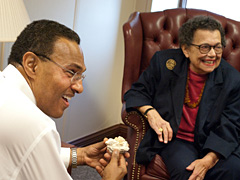Hands-on History
Marie Spiro had been collecting artifacts to use in her classroom at the University of Maryland, College Park for over 50 years. So when the archaeologist decided that it was time for her collection to find a new home, she looked for a place that would honor her one wish for the objects: that rather than living in cases, the artifacts would be used, handled and studied by students learning about archaeology and the ancient world.
She found such a place in UMBC’s ancient studies department, and the first third of Spiro’s collection arrived in the department—and the classroom—this semester. The collection features Greek, Roman and Byzantine artifacts, and contains mosaics, pottery, figurines and other pieces that date back as far as 15,000 years. The next third of the artifacts will come to campus in early 2012, with the final portion arriving in 2013.
“I’ve always wanted this to be passed on, and I have the opportunity to pass it along to an outstanding department,” Spiro said. “I’m so happy that the collection has found a home. That’s my dream fulfilled.”
The collection also fulfilled a dream for Marilyn Goldberg, chair of ancient studies, who was eager to extend the department’s focus on hands-on learning into the classroom. Although ancient studies undergraduate students participate in internships at places like the Walters Art Museum and digs in locations from Fell’s Point to Transylvania, Goldberg is thrilled that the Spiro collection allows students to physically interact with the artifacts without leaving campus. The collection is ideal for research and teaching because it includes many objects that ancient people used in their everyday lives.
“Students can look at a piece in its entirety, look at the back of it and the profile of it, see how it’s made,” Goldberg said. “You can’t turn a picture over.”
With the financial support of local Greek organizations, including the Baltimore-Piraeus Sister City Committee and the American Hellenic Educational Progressive Associations of Baltimore and Washington, DC, the ancient studies department brought the artifacts to campus this February.
The first students to work with the collection are currently enrolled in the Museum Studies class taught by Esther Read, lecturer in ancient studies. The class is a lecture/lab hybrid, with students spending the first half in discussion about the issues faced by museums and the second half working with the artifacts. Read has worked both in museums and on award-winning archaeology digs.
“I want them to see that these objects are more than just pretty things in cases. Whoever owned that piece originally, it had meaning to them, it had meaning to Marie Spiro when she collected it, it has different meaning now that she’s given it to us, it’ll have a meaning here at the institution and for the student who works with it,” said Read. “You have so many groups and so many relationships with one object. Which story do you present?”
Students will need to keep those issues in mind when Phase II of the Performing Arts and Humanities Building opens: it will include an archaeology lab where students can study the artifacts and space where they can display the exhibits they curate.
“There are so many potential projects,” said Goldberg. “I keep getting ideas about the possibilities for the collection and what we can do with it.”
(4/15/11)

